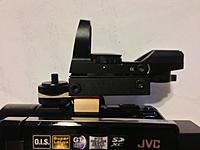Comments (1)
Add Comment
-
 Views: 650
Views: 650
My video camera mounted on a BushHawk. The sight on camera here was a Telerad. Not really suitable since it has a narrow view and the red dot is too faint and hard to see -
 Views: 580
Views: 580
This is the sight that I use as a sports finder to enable me to track airplanes without ping ponging. It has a variety of reticules, crosshairs, spots, etc. in both green and red as well as five levels of brightness.
-
 Views: 616
Views: 616
Fifinella on final. This design was created by Walt Disney for a future animated film on gremlins. When a logo was requested for WFTD (Women Flying Training Detachment), Fifinella was sent to war with the WASP WWII. -
 Views: 663
Views: 663
A Culver Cadet Drone of the type Brownie test flew on a daily basis at Camp Davis, North Carolina. These planes were used for gunnery practice. Some were painted silver. -
 Views: 643
Views: 643
Bobby Younkinís Beech 18 at the Sussex Airshow, 2004. This plane was probably ex-military since it was built in 1942. Bobby put on a terrific show in this plane that was never intended or designed for aerobatic performance. -
 Views: 662
Views: 662
My friend Brownie who, to my amazement had been friends with my flying instructor and a half a dozen people I knew,












